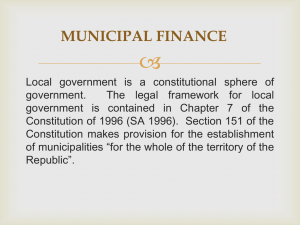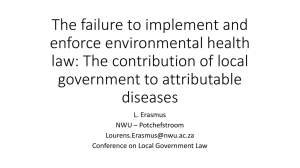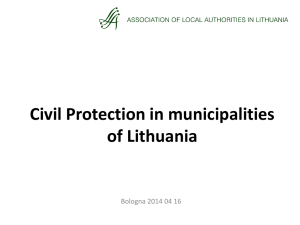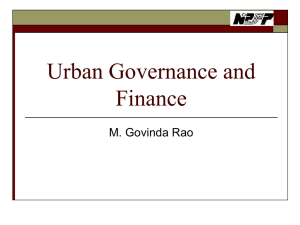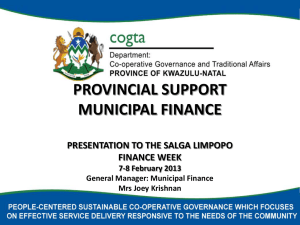2. Chapter 1 - Introduction to mSCOA_Final - MFMA
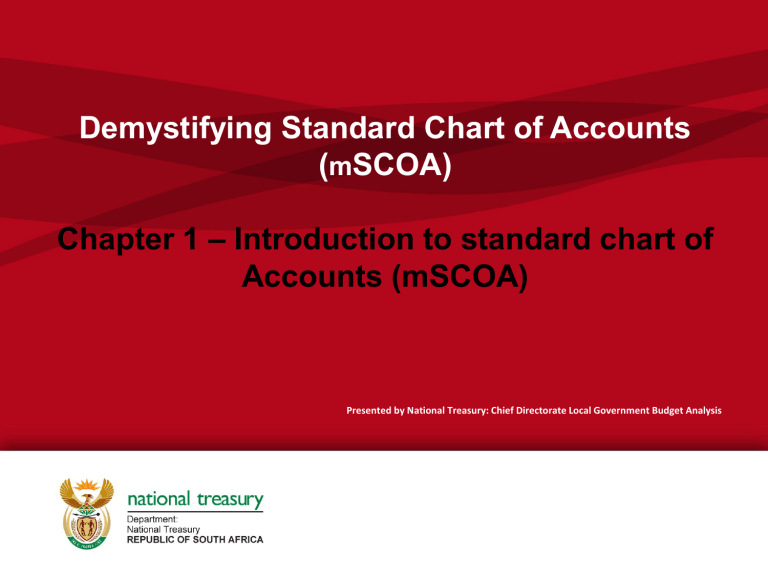
Demystifying Standard Chart of Accounts
(
m
SCOA)
Chapter 1 – Introduction to standard chart of
Accounts (mSCOA)
Presented by National Treasury: Chief Directorate Local Government Budget Analysis
Outcomes
• Explain the legislation enabling m SCOA in the local government.
• Explain the purpose and objectives m SCOA for local government.
• Explain the financial management reform process and the impact on m SCOA.
• Discuss the roles and responsibilities of the Accounting
Officer, Treasuries and m SCOA technical committee.
• Explain the impact of reporting requirements has on m SCOA.
• Understand what the mSCOA training is addressing.
2
The Road to mSCOA – The
Budget Reform
Programme
• We have embarked on the long-term local government financial reform programme (Evolutionary)
– MFMA Implementation in 2003
• We have issued a suite of regulations:
– Draft Municipal Finance Misconduct Regulation (July 2012)
– Municipal Budget and Reporting Regulations (April 2009)
– Municipal Asset Transfer Regulations (August 2008)
– Municipal Regulations on Debt Disclosure (June 2007)
– Municipal Supply Chain Management Regulations (May 2005)
– Municipal Investment and PPP Regulations (April 2005)
• We have developed a comprehensive budgeting system (Municipal Budget and Reporting Regulations)
• We have developed a conditional grant monitoring system
• Institutionalized annual engagements with the 17 non-delegated municipalities.
3
The Road to mSCOA – The
Budget Reform
Programme
• The budget reform programme was launched in 2009 with the publication of the regulations Government Gazette 32141 dated 17 April 2009 : Municipal Budget and
Reporting Regulations
• Objective
– To secure sound and sustainable management of budgeting and reporting practices of municipalities and municipal entities by establishing uniform norms and standards and other requirements for ensuring transparency, accountability and appropriate lines of responsibility in the budgeting and reporting processes of those institutions and other relevant matters as required by the Act.
• Introduced standardised budgeting reporting and formats
• Improved LG sphere’s ability to deliver basic services to all through:
– Improved financial sustainability
– Facilitation of medium term planning and policy choices on service delivery
• Standardised reporting and formats improved
– Credibility, Sustainability, Transparency, Reliability, Relevance; and
– Comparability of budgets and in year reports of municipalities and entities
4
The Road to mSCOA - The
Budget Reform
Programme
• Envisaged improvements
– Guided by the Constitution and the MFMA
– Promote transparency and accountability
– Strengthens the link between policy priorities, planning, budgeting, implementation and reporting
– Forms the basis for the Medium Term Revenue and Expenditure
Framework for municipalities (MTREF)
– Facilitates inter-local government comparability (to demonstrate the effective use of resources and to inform allocation decisions)
– Consistent budget and reporting formats that will support GFS
– Improve golden thread of reporting - adopted budgets, in-year reporting, AFS and Annual Report
5
The Road to mSCOA – Was the budget reform enough?
• Problem statement (1)
– 278 different municipal ‘charts of accounts’ (COA) a ggregation of budget and other information extremely difficult with inconsistent use of account labels and definitions across municipalities
–
Quality of municipal information is compromised due to lack of uniform classifications for revenue and expenditure items (posting level)
– Lack of consistent information across the IDP, Budget, SDBIP, IYM and AFS
–
Compromises monitoring and oversight by Councils, DCoG, treasuries and legislatures. In illustrating, 4 th Quarter results
– 2011/12 municipal MTREF:
•
Aggregate under spending of the adjusted operating budget
– R22.3 bn or 10.2%
•
Aggregate under spending of the adjusted capital budget
– R14,8 bn or 32.3%
• Under spending of conditional grants was R5.1 bn or 25.3%
•
Can this be attributed to ineffective budgeting and financial management practices? Over ambitious expenditure appropriations; unfunded budgets; lack of credibility in reporting (S71) – pure compliance; or a mixture)
•
This could further lead to incorrect decision making due to incorrectly classified transactions.
– Compromises government’s ability to formulate coherent policies affecting local government, and its ability to use the budget as a redistribution tool to address poverty and inequality
– Municipalities continuously change and amend detail COA
– No consistency year-onyear
6
The Road to mSCOA – Was budget reform enough ?
• Problem statement (2)
– In the absence of meaningful and credible management information municipal councils make uninformed decisions; considerable risk
– Contributing factor to weak audit opinions
– Lack of ownership by finance practitioners; inconsistency in the application of leading financial management practices corrupting the
“chart”
– COA information not easily obtainable in a useful format
– Metadata not defined
– Multi-year budgeting is a relatively new concept; constant changes to the COA impedes the ability to plan over the medium-term
– Electronic budget returns and in-year reporting not aligned to the adopted budget and budget information published by municipalities
7
The Road to mSCOA
A need was identified for a standard Chart of Accounts for Municipalities and
Municipal Entities
The
m
SCOA journey begins
8
The Road to mSCOA
National and Provincial Municipalities
9
The road to mSCOA – Legislative overview
10
The Road to mSCOA – Legal framework
Constitutional Requirements
Section 216(1) of the Constitution states that:
National legislation must establish a National Treasury and prescribe measures to ensure both transparency and expenditure control in each sphere of government, by introducing -
(a) Generally recognised accounting practice
(GRAP – OAG)
(b) Uniform expenditure classifications; and
(Standard Chart of Accounts / General Leger)
(c) Uniform treasury norms and standards
(MFMA, Regulations, Circulars and Guidelines)
11
The Road to mSCOA – Legal framework
MFMA Requirements
Section 168 (1) of the MFMA states that:
The Minister (of Finance), acting with the concurrence of the
Cabinet member responsible for local government, may make regulations for, among other things –
(a) any matter that may be prescribed …and…
(p) any other matter that may facilitate the enforcement and administration of the Act
12
The Road to mSCOA – The Regulations
• Local Government: Municipal Finance Management Act (56/2003):
Municipal Regulations on Standard Chart of Accounts (Gazette No. 37577)
– Key Objectives in preamble
• improved data quality and credibility;
• the achievement of a greater level of standardisation;
• the development of uniform data sets critical for 'whole-of-government‘ reporting;
• the standardisation and alignment of the 'local government accountability cycle' by the regulation of not only the budget and in-year reporting formats but also the annual report and annual financial statement formats;
• the creation of the opportunity to standardise key business processes with the consequential introduction of further consistency in the management of municipal finances;
• improved transparency, accountability and governance through uniform recording of transactions at posting account level detail;
• enabling deeper data analysis and sector comparisons to improve financial performance; and
• the standardisation of the account classification to facilitate mobility in financial skills within local government and between local government and other spheres as well as the private sector and to enhance the ability of local government to attract and retain skilled personnel.
13
The Road to mSCOA – The Regulations
• Object of the regulations
– to provide for a national standard for the uniform recording and classification of municipal budget and financial information at a transaction level by prescribing a standard chart of accounts for municipalities and municipal entities which
• are aligned to the budget formats and accounting standards prescribed for municipalities and municipal entities and with the standard charts of accounts for national and provincial government; and
• enable uniform information sets recorded in terms of national norms and standards across the whole of government for the purposes of national policy coordination and reporting, benchmarking and performance measurement in the local government sphere
14
The Road to mSCOA – The Regulations
• The regulations apply to all municipalities and municipal entities
– For municipal entities the reporting in annual financial statements and annual reports may differ due to commercial nature of some of the municipal entities.
– There is no exemption from the regulation for the application of m SCOA to municipal entities.
• Chapter 2
– Segments and classification framework for standard chart of accounts
• 7 Segments
– Implementation requirements
• 7 Segments
• must accurately record all financial transactions and data in the applicable segment.
• may not contain data which is mapped or extrapolated or which otherwise does not reflect transactions recorded or measured by the municipality or municipal entity
• Financial and business application
– hosting of the general ledger structure
– capable of accommodating and operating m SCOA
– portal allowing for free access, for information purposes, to the general ledger of the municipality or municipal entity, by any person authorised by the Director-
General or the Accounting officer of the municipality
15
The Road to mSCOA – The Regulations
• Chapter 3
– Minimum business process and system requirements
• These are still to be published
• Chapter 4
– Technical committee for standard chart of accounts
• Composition of committee
• Function of m SCOA committee
• Chapter 5
– Responsibilities of municipal functionaries
• Responsibilities of municipal councils and board of directors
• Responsibilities of accounting officers
• Chapter 6
– General
• Access by National Treasury
• Postponement of implementation and exemption
16
The Road to mSCOA
National and Provincial Municipalities
17
The Road to mSCOA – The Chart
18
Financial Reforms - Municipal Accountability
Cycle
NDP
MTSF
Understanding mSCOA
• Detailed Classification System
– Not GFS, GRAP or Budget Formats but classification system (Posting Level Detail) = m SCOA
– Provide sufficient detail for reporting through combining/selecting from segment detail into reporting formats prescribed by recognised stakeholders
– Reporting Formats – Provides report writer within financial systems application or stakeholder databases
• What does this mean?
– Provide for detail to be added by municipalities
– Clearly defined account labels (Metadata)
– Accounts to be standardised for all Munics/ME/Agencies
– Comprehensive “Design Principles” for segments and account groups
– “Grid” to select what is applicable to the municipality
20
21
Overall Design Principles for mSCOA
• Classification framework limited to financial information
• International standards, guidance and best practices
• Comply with legislative framework for local government
• Labels and accounts to be clearly defined
• Comprehensive framework (grid) to satisfy stakeholders needs
• Information to be easily extracted
• Alignment of financial and budget reporting formats
• Integration of GRAP standards
• Standardisation of terminology
• Standardisation of transaction classification
• Reporting on “whole-of-local government and government”
• Simple classification
• Financial system integration with optimised business and programme rules
Segments of SCOA for Municipalities
22
Roles and responsibilities – mSCOA Technical committee
• must review the classification framework and, where required, make recommendations to the Minister on amendments to that framework;
• must develop guidelines and training material that are aligned to the classification framework.
• must review the implementation of the standard chart of accounts in government as a whole to ensure the alignment of the standard chart of accounts provided for in the Regulations and the standard chart of accounts applicable in national and provincial government;
• when required to align the mSCOA regulations with changes to other legislation applicable to local government, must make recommendations to the Minister on amendments to the mSCOA regulations;
• must undertake such other functions relating to the implementation the regulations
23
Roles and responsibilities – National Treasury
• m SCOA Project Sponsor on behalf of the National Treasury.
• m SCOA Project Management leading up to 1 July 2017.
• Core m SCOA Project Team for m SCOA Project Phase 4 (Change
Management and Training).
• Assisting municipalities with budget implementation aligned to the m SCOA classification framework.
• Administrator and owner of the Local Government Data Base and related reporting system (LGDBRS)
• Benchmarking and budget oversight responsibility.
• Overall stakeholder management (Internal and external)
• Custodian of ensuring m SCOA is in compliance with relevant municipal legislative framework and associated norms and standards.
• Linkage of National and Provincial SCOA to m SCOA.
• Responsible for the development, implementation and maintenance of the classification framework for all 3 spheres of government.
24
Roles and responsibilities – Provincial
Treasuries
• Key role player in the change management and communication process.
• Oversee the implementation of m SCOA by all municipalities within the province with the aim of full compliance by 1 July 2017.
• Assist National Treasury in the risk management process.
• Engage with all municipalities and share information, resolve queries and provide guidance with implementation.
• Logistical arrangements as it relates to provincial workshops, training sessions and engagements.
25
Roles and responsibilities – other external role players
• AUDITOR GENERAL
• Audit municipalities within the Constitutional Mandate.
• Develop and inform production champions and auditors responsible for municipalities as to the content and classification framework inherent to m SCOA.
• Participate by sharing views, concerns and possible areas of non-compliance with the Office of the Accountant-General
• REGULATORS / STAKEHOLDER DEPARTMENTS
• Active participation in the development of m SCOA.
• Responsible for enforcing compliance to m SCOA as it relates to their mandate.
• Support National Treasury in “training and change management process”.
• SYSTEM VENDORS
• Development of system functionality (financial application) in support of the m SCOA classification framework, business rules, and reporting requirements at a transactional level.
• Actively contribute to the change management and awareness process.
• Active participation in the development process
26
Roles and responsibilities – Within the
Municipality
• MUNICIPAL COUNCIL
• Governance, oversight over municipalities implementation of mSCOA and managing risk inherent
• ACCOUNTING OFFICER
• Ultimately responsible for controls, administration and reporting in terms of the
Municipal Finance Management Act.
• Responsible for adherence and compliance to all legislation and regulations governing the municipality.
• Involvement of Internal Audit and Risk Manager.
• Delegating the necessary powers and duties to the appropriate officials.
• Ensuring that the responsible officials have the necessary capacity by providing training and ensuring that they attend training or workshops provided by National
Treasury.
• Ensuring that the financial and business applications of the municipality or municipal entity have the capacity to accommodate the implementation of these
Regulations and that the required modifications or upgrades are implemented
27
Roles and responsibilities – Within the
Municipality
• ACCOUNTING OFFICER
• submitting reports and recommendations to the municipal council or the board of directors, as the case may be, that provide for the adoption of any resolutions, policies and budgetary provisions necessary for the implementation of the
Regulations.
• Identification of Project Manager, Project Office and development of Project Plan guiding the municipality with implementation
• Oversight of progress with SCOA implementation.
• Internal change management agent
28
National Treasury Training initiatives
18 Nov to 9 Dec
2014
March to April 2015
29
National Treasury Training initiatives
July 2015 onwards
30
Questions
31

